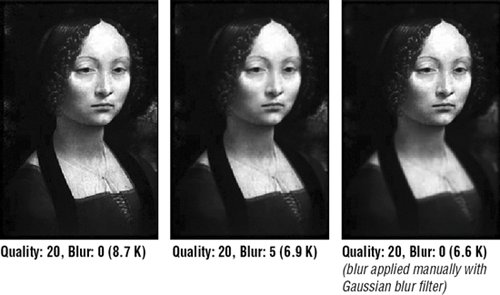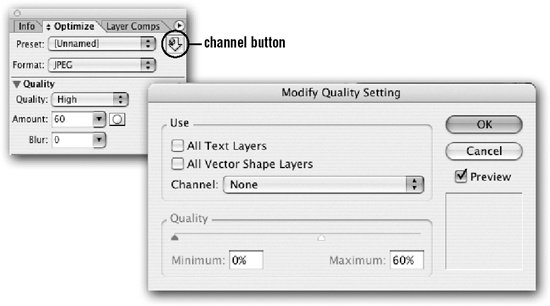Section 30.5. Minimizing JPEG File Size
30.5. Minimizing JPEG File SizeAs for all files intended for web delivery, it is important to optimize JPEGs to make the file size as small as possible. Because JPEGs are always 24-bit by nature, reducing bit-depth is not an option. For the most part, all you have to play with is the Quality setting, but it is possible to prepare an image prior to compression. There are a number of strategies and tools available for making JPEGs as small as they can be while letting you make decisions about image quality. 30.5.1. Aggressive Compression RatiosThe most direct way of optimizing a JPEG is to adjust its Quality setting. If your image has a lot of continuous tone or gradient colors, you can be pretty aggressive with the compression level and not worry too much about loss of quality in the resulting JPEG. Even at some of the lowest quality settings, the image quality is still suitable for viewing on web pages. Of course, this depends on the individual image. A low quality setting (for example, below 30 in Photoshop) usually results in a blocky or blotchy image, which may be unacceptable to you. Each tool provides sliders for controlling quality/compression ratios, although they use different numbering systems. Fireworks uses a percentage value from 1 to 100%. Paint Shop Pro uses a scale from 1 to 100, but it works as the inverse of the standard scale: lower numbers correspond to higher image quality and less compression. Photoshop uses a scale of 0 to 12 when you select JPEG from the Save As dialog box. When you choose Save for Web in Photoshop or Save Optimized in ImageReady, the quality rating is on a scale from 0 to 100. It should be noted that Photoshop is much less aggressive with its numbering; 0 on the Photoshop scale corresponds to about 30 on the standard scale. The easiest way to get the balance of compression and image quality just right is to watch the effects of your settings in the image preview available in Photoshop/ImageReady and Fireworks. 30.5.2. "Optimized" JPEGsStandard JPEGs use a precalculated, general purpose compression table (called the Huffman table ) for compressing an image. Some tools offer the ability to create an "optimized" compression table that is customized for the particular image. This results in better color fidelity and slightly smaller file sizes. To optimize a JPEG in Photoshop/ImageReady, simply put a check next to "Optimize" in the Save for Web or Optimize palettes. 30.5.3. Softening the Image for Better CompressionJPEG compression does an admirable job of condensing photographic images without requiring much extra attention. However, if you are serious about making your JPEGs as compact as possible, you may want to maximize JPEG compression's strengths by feeding it the kind of image it likesan image with subtle gradations, fewer details, and no hard edges. By applying a slight blur to all or part of the image, you allow the compression scheme to do its work more efficiently. If you are using Photoshop/ImageReady or Fireworks, you will find a setting with the optimization options that softens the image. In Photoshop, the tool is called Blur; in Fireworks, it's Smoothing. If you apply a soft blur, the JPEG compression works better, resulting in a smaller file. If you don't have these tools, you can soften the whole image manually by applying a slight blur to the image with the Gaussian Blur filter (or similar). Compare the file sizes of the original image (left) and the slightly blurred image (center) in Figure 30-2. A more sophisticated approach is to apply aggressive blurs to areas of the image that are not important and leave areas of detail alone. For instance, if you are working with a portrait, you could apply a blur to the background while maintaining detail in the face, as shown in the example on the right in Figure 30-2. Figure 30-2. Blur all or part of an image for smaller file sizes 30.5.4. Weighted Optimization (Photoshop/ImageReady)Photoshop and ImageReady offer a Weighted Optimization function that lets you smoothly vary the optimization settings across an image using an alpha channel (also called a mask). This allows you to let Photoshop know in which areas of the image quality should be preserved, and where quality may be sacrificed to achieve a smaller file size. To save a JPEG with Weighted Optimization in Photoshop, first select the portion of the image that you want to retain the highest quality. Save the selection (using the Select menu) and give it a name. This creates the alpha channel that will be referenced when optimizing the image. From the Save for Web dialog box, select the channel button to the right of the Quality text box (see Figure 30-3). In the Modify Quality Setting dialog that appears, select your named channel from the pop-up menu. Use the sliders to set the minimum (applied to black areas of the mask) and maximum (applied to white areas of the mask) quality levels. The results of your settings can be seen in the Optimized Preview. Figure 30-3. Weighted Optimization for JPEGs using ImageReady 30.5.5. Selective Quality (Fireworks)Fireworks has a function called Selective Quality that works similarly to Photoshop's Weighted Optimization by allowing you to compress different areas of a JPEG at different levels. To compress selected areas of a JPEG, select an area of the image and choose Modify 30.5.6. Optimize to File Size (Photoshop/ImageReady)If you know ahead of time the size you'd like your JPEG to be, try using the Optimize to File Size feature in Photoshop/ImageReady. Optimize to File Size (accessible via the Save for Web dialog box) allows you to achieve your target file size automatically without trying out lots of different optimization settings. The Optimize to File Size function as it applies to GIFs is discussed in Chapter 29 (see Figure 29-10). |
EAN: 2147483647
Pages: 325
 Selective JPEG
Selective JPEG